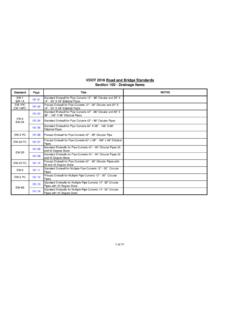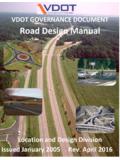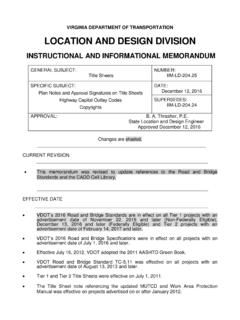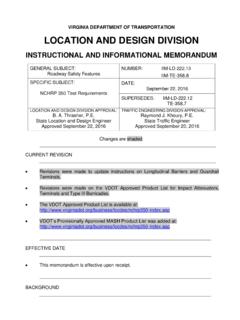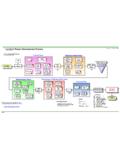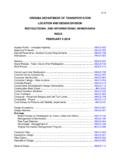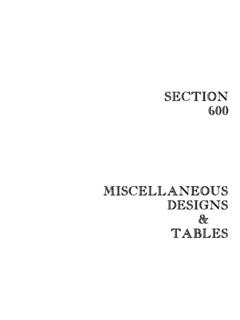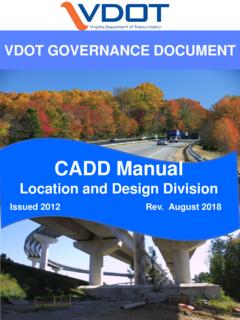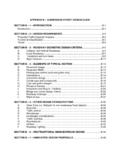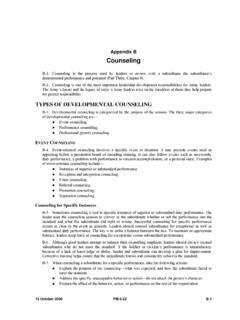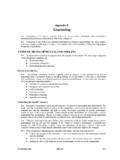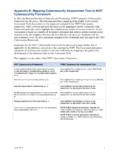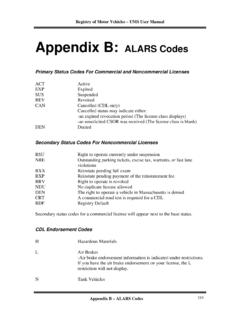Transcription of APPENDIX B – SUBDIVISION STREET DESIGN GUIDE
1 APPENDIX B SUBDIVISION STREET DESIGN GUIDE . SECTION B 1 INTRODUCTION. Introduction ..B-1. SECTION B 2 DESIGN REQUIREMENTS. Projected Traffic/Capacity Analysis ..B-2. Functional SECTION B 3 ROADWAY GEOMETRIC DESIGN CRITERIA. A. Collector and Arterial Roadways ..B-5. B. Local Roadways ..B-5. C. Transitions and Turn Lanes ..B-6. SECTION B 4 ELEMENTS OF TYPICAL SECTION. A. Pavement B. Pavement Width ..B-13. C. Parking Lane Widths (Curb and Gutter Only) ..B-14. D. Intersections ..B-14. E. Concentric F. Cul-de-sacs and Turnarounds ..B-16. H. Private I. Pedestrian and Bicycle Facilities ..B-24. J. Bridge and Culvert DESIGN Criteria ..B-28. K. Roadway Drainage ..B-28. L. Right-of-Way ..B-31. SECTION B 5 OTHER DESIGN CONSIDERATIONS. A. Clear Zone ( Setback for non-breakaway fixed objects)..B-32. B. Guardrail ..B-34. C. Traffic Control ..B-34. D. E. Landscape Considerations ..B-35. F. Traffic Calming ..B-38. G. Roundabouts ..B-40. H.
2 Utilities ..B-40. I. Roadway Lighting ..B-42. SECTION B 6 NEOTRADITIONAL NEIGHBORHOOD DESIGN ..B-44. SECTION B 7 INNOVATIVE DESIGN PROPOSALS ..B-46. List of Tables Geometric DESIGN Standards for Residential SUBDIVISION Streets Table 1 Curb and Gutter Section .. B-7. Table 2 Shoulder and Ditch Section .. B-8. Table 3 One-Lane (One-Way) SUBDIVISION Streets .. B-9. Table 4 School Bus Access Road .. B-10. Table 5 Maximum Grade Lengths for Shared Use Paths .. B-26. List of Figures Figure 1 "Exhibit 2-4" scanned from "A Policy on Geometric DESIGN of Highways and Streets, AASHTO, 2001 .. B-5. Figure 2 Sight Distance Triangles .. B-12. Figure 3 Intersection DESIGN .. B-15. Figure 4 Cul-de-sac details .. B-18. Figure 5 Curb and Gutter Details .. B-19. Figure 6 Detail back of B-21. Figure 7 Roll top curb entrance B-22. Figure 8 Rolltop curb entrance detail section .. B-22. Figure 9 Private Entrance Detail .. B-23. Figure 10 Setback Details with Curb and Gutter.
3 B-33. Figure 11 Setback Details with Shoulder and B-33. B-1. APPENDIX B SUBDIVISION STREET DESIGN GUIDE . SECTION B 1 INTRODUCTION. INTRODUCTION. This document is an APPENDIX of VDOT's Road DESIGN Manual and is intended for users of VDOT's SUBDIVISION STREET Requirements for the development of new SUBDIVISION streets functionally classified as local streets. All other streets must be developed in accordance with appropriate provisions of the Road DESIGN Manual for the appropriate functional classification. For the purposes of this document, Resident Engineer means that employee who oversees the land development functions for the residency. This may be the Resident Engineer, Residency Administrator or that employee designated to perform the responsible charge duties for the residency or other designee as determined by the District *Engineer/Administrator. In the context of this document, the term can also refer to A. In Districts having centralized functions, it means the Land Development Manager, Residency Permit manager or that employee designated to oversee land development functions.
4 B. In cities or towns choosing to use this DESIGN GUIDE for the DESIGN of their SUBDIVISION streets, it means the local official responsible for the review and approval of SUBDIVISION STREET DESIGN . In the event of conflict between this APPENDIX and other provisions of the Road DESIGN Manual, Road and Bridge Standards, and the SUBDIVISION STREET Requirements, the Resident Engineer shall determine the governing provision. As indicated in the SUBDIVISION STREET Requirements, any requirements of the SUBDIVISION ordinance of the locality that are greater than these requirements shall govern. The Resident Engineer is provided considerable discretionary authority in the application of standards related to local SUBDIVISION streets. The District Engineer/Administrator is authorized to consider and render a decision on unresolved issues between the developer and the resident engineer that pertain to the interpretation and application of this APPENDIX .
5 All appeals shall be made in writing describing the unresolved issue and include copies of all prior relative correspondence. All land development proposals should be submitted to the local jurisdiction, which will then coordinate with the local Resident Engineer or Northern Virginia District's Land Development Section for VDOT review and approval. The Resident Engineer or Land Development Office will coordinate with other VDOT sections as needed. *. Rev. 7/15. B-2. SECTION B 2 DESIGN REQUIREMENTS. PROJECTED TRAFFIC/CAPACITY ANALYSIS. For the purposes of these requirements, "projected traffic" includes the traffic resulting from the complete development of all land to be served by the subject roadway facility, including traffic forecast to be generated by development, both internal and external, to the SUBDIVISION under consideration. The basis for this forecast will be the governing body's current comprehensive plan or other available information pertinent to the permitted land use and transportation planning for the SUBDIVISION and adjacent properties.
6 The trip generation rates in the current version of Trip Generation, published by the Institute of Transportation Engineers (ITE) should be utilized in determining the projection of traffic. The ITE trip generation rate for a single-family detached residential dwelling unit is currently 10. vehicle trips per day. The use of other bona fide traffic studies in determining projected traffic for all types of land development may be considered, subject to their submission for review and approval by the department. In PUD developments, trip generation rates should be developed for each type of land use and combined to determine projected traffic for each of the SUBDIVISION streets. As an alternative to the application of the projected traffic to the applicable geometric DESIGN criteria of these requirements, the department will consider SUBDIVISION STREET DESIGN based on a capacity analysis concept provided: 1. The governing body permits the utilization of this concept in the DESIGN of SUBDIVISION streets in the county.
7 2. The developer furnishes full rationale, from an engineer licensed by the Commonwealth to perform such studies, to support the recommendations of this analysis. The submission should include all pertinent traffic data and computations affecting the DESIGN proposal for the SUBDIVISION streets involved. 3. An acceptable level of service should be accommodated in the STREET DESIGN proposed under the capacity analysis concept. A minimum level of service D . as defined by the Highway Capacity Manual is generally acceptable for the DESIGN of local SUBDIVISION streets. To maintain an acceptable level of service, additional travel lanes, channelized roadways, etc., may be required. B-3. FUNCTIONAL CLASSIFICATION. The characteristics and magnitude of the service to be provided will be the basis for the department's determination of the functional classification for each SUBDIVISION STREET intended for acceptance into the secondary system.
8 AASHTO's Geometric DESIGN of Highways and Streets provides guidance in the classification of roads. The hierarchy of the functional systems consists of principal arterials (for main movement), minor arterials (distributors), collectors and local roads and streets. Local streets are defined as those streets that provide direct access to adjacent land and serve travel of short distances as compared to the higher systems. Service to through traffic is discouraged. Most SUBDIVISION streets fall in the Local STREET classification. The geometric DESIGN standards contained in this GUIDE should be used for streets classified as local roads. All other STREET classifications should use VDOT's Road DESIGN Manual for geometric DESIGN . 1. Criteria Urban and rural areas have fundamentally different characteristics. Consequently, urban and rural functional systems are classified separately. Most SUBDIVISION streets function similar to an urban area; therefore, the urban classification can be used for high-density development with the concurrence of the locality and Resident Engineer.
9 2. Procedures The department's concurrence of the functional classification for each STREET within a SUBDIVISION should be made prior to departmental approval of a SUBDIVISION concept plan. To facilitate the effective development of the plats or plans and permit an expeditious review, this concurrence is recommended prior to the initiation of a detail DESIGN for the SUBDIVISION . To initiate the functional classification process, the developer should submit the following information: a. A sketch accurately depicting the general concept for the proposed development of the SUBDIVISION , in conformance with the applicable provisions of the governing body's zoning and SUBDIVISION regulations. This sketch should include: (1.) The general location and configuration of each STREET proposed within the SUBDIVISION , including the terminus and right of way, including but not limited to anticipated average daily traffic volumes, anticipated percentage of trucks, peak hour traffic volumes, and any proposed phased development of streets.
10 (2.) The location and area of each type of permitted land use within the SUBDIVISION . B-4. (3.) The location of any proposed transportation facility, within the SUBDIVISION 's boundaries, included in the current comprehensive plan of the governing body. (4.) The proposed functional classification of each STREET within the SUBDIVISION . (5.) Where the governing body's zoning or SUBDIVISION regulations, or both, require submission of a conceptual plan in general conformance with the submission of the concept plan noted, such may be acceptable for review by the Resident Engineer. b. Other available information pertinent to the intended development of the SUBDIVISION . c. Any STREET proposed for phased development should be reviewed at this time and be approved for such development by the local government and the department. 3. Approval The Resident Engineer will provide written concurrence to the appropriate county official and the developer, if applicable, regarding the approved functional classification for each STREET in the SUBDIVISION .

